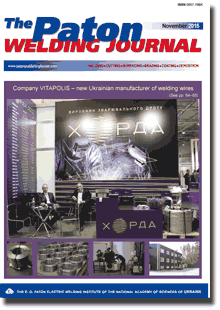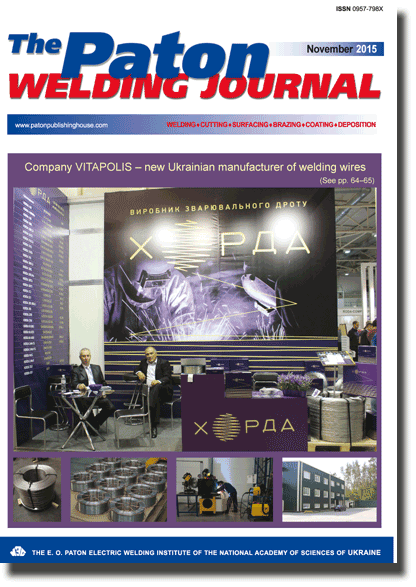Access for download PDF files for subscribers and for reviewers of scientometric bases.
Organization: Elsevier for content access(PDF files of journals released before 2024 are available for download from the website's archives))
Organization: Elsevier for content access(PDF files of journals released before 2024 are available for download from the website's archives))
| 2015 №11 (07) |
DOI of Article 10.15407/tpwj2015.11.08 |
2015 №11 (09) |

The Paton Welding Journal, 2015, #11, 57-60 pages
Determination of force caused by heating of ring-type products in flash-butt welding
A.V. Moltasov, K.V. Gushchin, I.N. Klochkov, P.N. Tkach And A.I. Tarasenko
E.O. Paton Electric Welding Institute, NASU 11 Bozhenko Str., 03680, Kiev, Ukraine. E-mail: office@paton.kiev.ua
Abstract
In flash-butt welding of products of a closed shape the force, which welding machine should provide for high-quality formation of welded joint in a solid phase, is determined not only by upsetting force but also by force spent for bending the part itself, and by force caused by heating of shunting part. Therefore, when choosing the equipment for welding of any product of closed shape it is necessary to determine the total force, which welding machine should provide. The experimental measurements of temperature in different characteristic points at the final stage of the process of FBW of the ring of steel 20 in machine K-724 were carried out. It was established that the temperature in the shunting part is changed both along the circumferential as well as along the radial coordinate. The existing procedure for description of temperature field was improved so that in determination of the Fourier coefficients not only the experimental data were used, but also the data obtained by computer modeling. Basing on the postulates of the proposed model the function of general form was obtained, which allows determining the temperature at any point of the shunting part using an unlimited number of terms of approximated series. The calculation of power parameters of FBW with pulsed flashing of the investigated ring was carried out. As a result, it was established that the force caused by heating of the shunting part, amounted to 9.1 % of the total force required for quality formation of the joint. The value of temperature force is connected with the value of equivalent temperature displacement. The estimated value of this displacement, corresponding to the proposed model, correlates well with the results of numerical modeling of temperature displacements in the welded billet. 11 Ref., 1Table, 3 Figures.
Keywords: flash-butt welding, ring-type products, shunting currents, temperature field, Fourier series, temperature force
Received: 11.02.15
Published: 21.12.15
References
- Pavlichenko, V.S. (1964) Resistance welding of closed-shape products. Moscow: Mashinostroenie.
- Kuchuk-Yatsenko, S.I. (1992) Flash butt welding. Kiev: Naukova Dumka.
- Kuchuk-Yatsenko, S.I, Chvertko, P.N., Semyonov, L.A. et al. (2013) Flash butt welding of products of high-strength alloys based on aluminium. The Paton Welding J., 7, 2-6.
- Gelman, A.S. (1952) Technology of electric resistance welding. Moscow: Mashgiz.
- Kabanov, N.S. (1973) Welding on resistance machines. Moscow: Vysshaya Shkola.
- Moltasov, A.V., Samotryasov, S.M., Knysh, V.V. et al. (2014) Influence of non-uniformity of heating on upsetting force value and forging time in flash-butt welding of flat ring. The Paton Welding J., 10, 11-14. https://doi.org/10.15407/tpwj2014.10.02
- Karslou, G., Eger, D. (1964) Thermal conductivity of solids. Moscow: Nauka.
- Timoshenko, S.P., Goodier, J. (1975) Theory of elasticity. Moscow: Nauka.
- Boli, B., Ueiner, J. (1964) Theory of temperature stresses. Moscow: Mir.
- Chvertko, P.N., Moltasov, A.V., Samotryasov, S.M. (2014) Calculation of upsetting force in flash butt welding of closed-shape products. The Paton Welding J., 1, 46-50. https://doi.org/10.15407/tpwj2014.01.07
- Kuchuk-Yatsenko, S.I., Didkovsky, V.A., Bogorsky, M.V. et al. Method of flash butt welding. Pat. 46820 Ukraine. Publ. 17.06.2002.
Suggested Citation
A.V. Moltasov, K.V. Gushchin, I.N. Klochkov, P.N. Tkach And A.I. Tarasenko (2015) Determination of force caused by heating of ring-type products in flash-butt welding. The Paton Welding J., 11, 57-60.The cost of subscription/purchase order journals or individual articles
| Journal/Currency | Annual Set | 1 issue printed |
1 issue |
one article |
| TPWJ/USD | 384 $ | 32 $ | 26 $ | 13 $ |
| TPWJ/EUR | 348 € | 29 € | 24 € | 12 € |
| TPWJ/UAH | 7200 UAH | 600 UAH | 600 UAH | 280 UAH |
| AS/UAH | 1800 UAH | 300 UAH | 300 UAH | 150 UAH |
| AS/USD | 192 $ | 32 $ | 26 $ | 13 $ |
| AS/EUR | 180 € | 30 € | 25 € | 12 € |
| SEM/UAH | 1200 UAH | 300 UAH | 300 UAH | 150 UAH |
| SEM/USD | 128 $ | 32 $ | 26 $ | 13 $ |
| SEM/EUR | 120 € | 30 € | 25 € | 12 € |
| TDNK/UAH | 1200 UAH | 300 UAH | 300 UAH | 150 UAH |
| TDNK/USD | 128 $ | 32 $ | 26 $ | 13 $ |
| TDNK/EUR | 120 € | 30 € | 25 € | 15 € |
AS = «Automatic Welding» - 6 issues per year;
TPWJ = «PATON WELDING JOURNAL» - 12 issues per year;
SEM = «Electrometallurgy Today» - 4 issues per year;
TDNK = «Technical Diagnostics and Non-Destructive Testing» - 4 issues per year.


